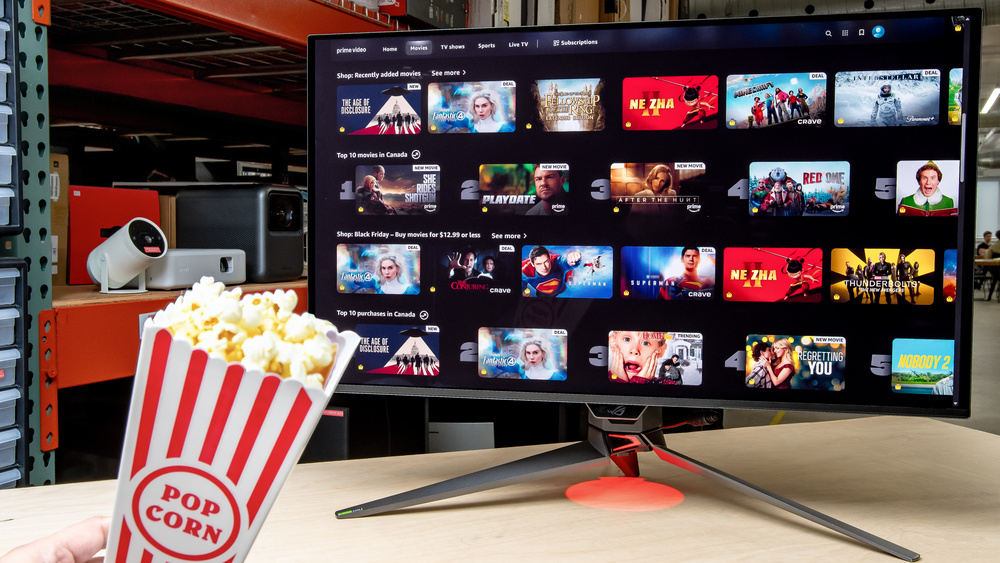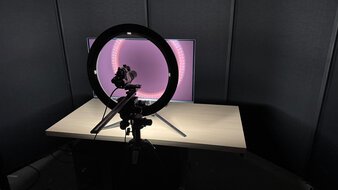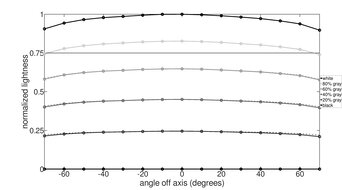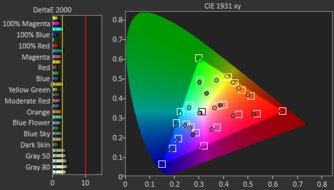Monitors have become a great alternative to TVs if you want a smaller display for watching movies and shows. There are a number of monitors with OLED panels, and even some budget and mid-range monitors have full-array Mini LED backlighting, providing great picture quality. Although monitors have less image processing and upscaling power than TVs, they're also versatile for gaming or productivity, so they're great choices for different uses besides just watching content.
When looking for a new monitor for watching content, there are a few factors to consider. One of the most important is having a high contrast ratio, which helps the monitor display deep blacks against bright highlights, particularly in dark rooms, and OLEDs excel at this. Having a monitor with high brightness is also useful if you want to watch content in bright rooms. Lastly, it's important for the monitor to display a wide range of accurate colors so that images look life-like. You should also consider whether you're going to watch your content in SDR or HDR, as some monitors are better for HDR than others.
We've bought and tested more than 375 monitors, and below, you'll find our recommendations for the best multimedia monitors available. See our recommendations for the best HDR monitors, the best OLED monitors, and the best Mini LED monitors. If you want more options for watching content, check out the best TVs for movies.
Quick Look

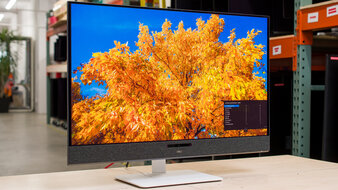



We buy and test more than 30 monitors each year, with units that we buy completely on our own, without any cherry-picked units or samples. We put a lot into each unbiased, straight-to-the-point review, and there's a whole process from purchasing to publishing, involving multiple teams and people. We do more than just use the monitor for a week; we use specialized and custom tools to measure various aspects with objective data-based results. We also consider multiple factors before making any recommendations, including the monitor's cost, its performance against the competition, and whether or not it's easy to find.
-
Best Multimedia Monitor
 HDR Picture9.4SDR Picture10Brightness7.2Color Accuracy9.2Size27"Pixel TypeQD-OLEDMax Refresh Rate240 HzNative Resolution3840 x 2160See all our test resultsDolby VisionYes
HDR Picture9.4SDR Picture10Brightness7.2Color Accuracy9.2Size27"Pixel TypeQD-OLEDMax Refresh Rate240 HzNative Resolution3840 x 2160See all our test resultsDolby VisionYesThe best monitor for movies and multimedia content that we've tested so far is the ASUS ROG Swift OLED PG27UCDM, which is a premium 4k QD-OLED monitor. The main advantage of getting this for watching content is that it has remarkable picture quality. Its QD-OLED panel displays deep and inky blacks in dark rooms, and it has a wide range of vivid colors that make your favorite content look realistic. It also makes small highlights pop against the rest of the image, which is ideal for watching HDR content.
Another positive is that it supports Dolby Vision, so it can take full advantage of content available in that format, like from a Blu-ray player or Xbox Series X|S. However, one thing to know is that a QD-OLED like this performs best in a dark room. Using it in a bright room causes the black levels to rise, making them look purple. If you want a monitor that has better black levels in bright rooms, you can also check out the ASUS ROG Strix OLED XG32UCWMG. It's a WOLED with a TrueBlack glossy coating that maintains low black levels in a well-lit environment, but its colors aren't as vivid as the PG27UCDM.
-
Best Upper Mid-Range Multimedia Monitor
 HDR Picture9.3SDR Picture10Brightness6.7Color Accuracy8.4Size32"Pixel TypeQD-OLEDMax Refresh Rate120 HzNative Resolution3840 x 2160See all our test resultsDolby VisionYes
HDR Picture9.3SDR Picture10Brightness6.7Color Accuracy8.4Size32"Pixel TypeQD-OLEDMax Refresh Rate120 HzNative Resolution3840 x 2160See all our test resultsDolby VisionYesIf you find that the ASUS ROG Swift OLED PG27UCDM is too expensive but still want premium picture quality, then check out the Dell S3225QC, which costs a lot less than the ASUS. Besides a few differences in gaming features, which doesn't matter for watching multimedia content, there are minimal differences between this and the ASUS. Blacks are deep and inky in dark rooms, and the monitor displays a wide range of vivid colors with bright highlights. It also supports Dolby Vision and has a 4k resolution and QD-OLED panel like the ASUS, so it delivers detailed images. It even comes with five 5W speakers, which sound good for monitor speakers, but you still need a proper audio device for the best listening experience.
One main downside is that it doesn't get as bright as the ASUS, so it performs worse in bright rooms, but like with the ASUS, it looks best in a dark room anyway. Another difference is that it isn't as accurate in HDR, because it displays some dark content darker than what the creator intended, but this is the trade-off for getting something cheaper.
-
Best Mid-Range Multimedia Monitor
 HDR Picture6.8SDR Picture7.1Brightness8.7Color Accuracy8.5Size27"Pixel TypeIPSMax Refresh Rate320 HzNative Resolution3840 x 2160See all our test resultsDolby VisionNo
HDR Picture6.8SDR Picture7.1Brightness8.7Color Accuracy8.5Size27"Pixel TypeIPSMax Refresh Rate320 HzNative Resolution3840 x 2160See all our test resultsDolby VisionNoIf you find that the Dell S3225QC is still too much out of your price range or you can't find it on sale, look into the Acer Nitro XV275K P5biipruzx. Like the Dell, it's a 4k option, but there are a few trade-offs to getting this. As it doesn't have an OLED panel, it doesn't display the same perfect blacks without any haloing. Instead, it uses Mini LED backlighting that gets much brighter, so it's a better choice to use in well-lit rooms. Its local dimming feature also helps it improve black levels in HDR, while maintaining these low black levels in bright rooms. However, you can't use this local dimming feature in SDR, so it has much worse picture quality with blacks that look gray. If you want to watch content in SDR, you can check out the ASUS ROG Strix OLED XG27AQDMG instead, which is an OLED with better picture quality, but it has a lower resolution.
As for the Acer, it displays a wide range of colors in HDR and makes them look fairly similar, similar to the Dell. Unfortunately, it lacks a few features that the Dell has, as it doesn't have Dolby Vision support or built-in speakers, but it has an audio jack to easily connect speakers or a small soundbar.
-
Best Budget Multimedia Monitor
 HDR Picture8.0SDR Picture8.2Brightness8.3Color Accuracy8.8Size27"Pixel TypeVAMax Refresh Rate180 HzNative Resolution2560 x 1440See all our test resultsDolby VisionNo
HDR Picture8.0SDR Picture8.2Brightness8.3Color Accuracy8.8Size27"Pixel TypeVAMax Refresh Rate180 HzNative Resolution2560 x 1440See all our test resultsDolby VisionNoIf you're looking for the best monitor for watching movies and you're on a budget, there's a more limited selection of good monitors to choose from compared to higher-end displays. That said, there are still some options that are better than other entry-level displays for HDR, which is the case with the AOC Q27G3XMN. It's different than the Acer Nitro XV275K P5biipruzx because it has a lower 1440p resolution, so images aren't as detailed. On the plus side, it's another Mini LED option that actually has better picture quality than the Acer.
Besides the local dimming feature helping improve its contrast ratio with minimal haloing and bright highlights, you can use this feature as you wish in SDR and HDR. This means the AOC is better than the Acer for watching content in SDR, and even if you don't want to use local dimming, it displays deep blacks. It also gets very bright, and if you want an option that gets even brighter, the similar AOC Q27G40XMN is a good alternative. However, it can be harder to find depending on your region.
Notable Mentions
-
ASUS ROG Swift OLED PG32UCDM:
The ASUS ROG Swift OLED PG32UCDM is a 4k QD-OLED that's a larger alternative to the ASUS ROG Swift PG27UCDM. It performs similarly for the most part, but you're paying extra for the bigger size.
See our review -
BenQ MOBIUZ EX321UX:
The BenQ MOBIUZ EX321UX is a premium 4k monitor that's brighter than the ASUS ROG Swift OLED PG27UCDM thanks to its Mini LED backlighting. However, it doesn't display the same deep blacks, so it has worse picture quality than the ASUS.
See our review -
LG 27GX700A-B:
The LG 27GX700A-B is an upper mid-range monitor that usually costs around the same as the Dell S3225QC. The main advantage of getting this LG monitor is that it gets brighter than the Dell, thanks to its RGB Tandem OLED panel. However, it has a lower resolution, and it overbrightens content in HDR.
See our review -
Samsung Smart Monitor M80D S32DM80:
The Samsung Smart Monitor M80D S32DM80 is a 32-inch, 4k monitor with a built-in smart platform, which is useful if you want the best monitor to watch movies without a PC. While it's in the same price range as the Acer Nitro XV275K P5biipruzx, it also has worse picture quality.
See our review
Recent Updates
Dec 08, 2025:
We made several changes to better reflect the current monitor market and ensure consistency with other recommendations. We replaced the ASUS ROG Swift OLED PG32UCDM, the Dell Alienware AW2725Q, the ASUS ROG Strix OLED XG27AQDMG, and the AOC Q27G40XMN with the ASUS ROG Swift OLED PG27UCDM, the Dell S3225QC, the Acer Nitro XV275K P5biipruzx, and the AOC Q27G3XMN. In the Notable Mentions, we replaced the MSI MPG 322URX QD-OLED, the Dell Alienware AW3225QF, and the PG27UCDM with the PG32UCDM, the BenQ MOBIUZ EX321UX, and the LG 27GX700A-B.
Aug 06, 2025:
We replaced the AOC Q27G3XMN with the AOC Q27G40XMN, as the Q27G3XMN is hard to find. We also replaced the MSI MPG 321URX QD-OLED with the MSI MPG 322URX QD-OLED and the Gigabyte AORUS FO27Q3 with the ASUS ROG Swift OLED PG27UCDM in the Notable Mentions.
Apr 25, 2025:
We replaced the Samsung Odyssey OLED G80SD S32DG80 with the ASUS ROG Swift OLED PG32UCDM for consistency with other articles, as the ASUS supports Dolby Vision. We also replaced the Gigabyte AORUS FO27Q3 with the Dell Alienware AW2725Q, which has a higher resolution, and the Acer Nitro XV275K P3biipruzx with the ASUS ROG Strix OLED XG27AQDMG because it has an OLED panel. We removed the Acer Nitro XV275U P3biipx because it's unavailable now. Lastly, we replaced the MSI MPG 271QRX QD-OLED with the FO27Q3 in the Notable Mentions.
Feb 19, 2025:
We replaced the MSI MPG 271QRX QD-OLED with the Gigabyte AORUS FO27Q3 because the Gigabyte is more accurate in HDR. We also replaced the Samsung Smart Monitor M8/M80C S32CM80, Dell Alienware AW2725DF, and ASUS ROG Swift OLED PG32UCDM with the MSI MPG 271QRX QD-OLED, MSI MPG 321URX QD-OLED, and Samsung Smart Monitor M8/M80D S32DM80 in the Notable Mentions to reflect changes and the current market. Lastly, we introduced a new format to the article.
Dec 19, 2024:
We replaced the Gigabyte AORUS FO27Q3 with the MSI MPG 271QRX QD-OLED for consistency with other recommendations. We also added the Acer Nitro XV275U P3biipx as the 'Best Cheap' and the ASUS ROG Swift OLED PG32UCDM to Notable Mentions to give other options.
All Reviews
Our recommendations are based on what we think are the best monitors for watching movies and other types of multimedia content currently available. They're adapted to be valid for most people in each price range. The rating is based on our review, factoring in price and feedback from our visitors.
If you would prefer to make your own decision, here's the list of all of our monitor reviews. Be careful not to get too caught up in the details. Most monitors are good enough to please most people, and the metrics that fare worse are often not noticeable unless you really look for them.
